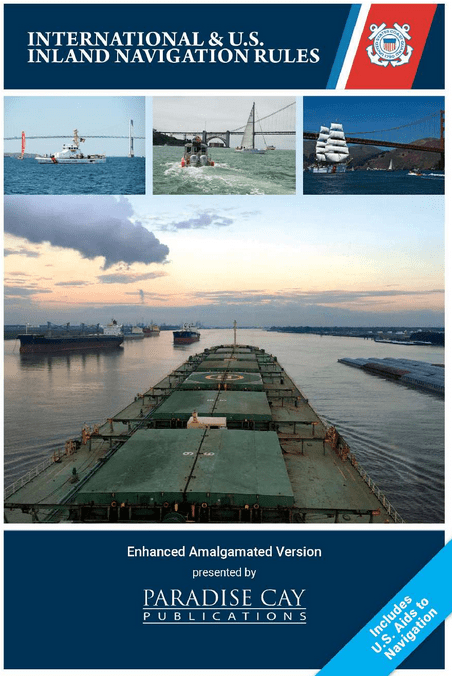Description
This version of the new amalgamated navigation rules to be easier to use. Larger text Easy to read font Larger images 6 x 9" trim size IS more portable USCG Aids To Navigation System included at the back of the book.
This publication is an amalgamation of the International Regulations for Preventing Collisions at Sea (72 COLREGS) and Inland Navigation Rules, their Annexes, and associated Federal rules and regulations. The format of this publication uses a single-page layout that concisely sets out the differences between each set of rules. We strive to ensure its accuracy; nonetheless, we make no claims or guarantees of such and expressly disclaim liability for its use.
An up to date printed or downloaded* copy of this Amalgamation, or the Navigation Rules as published within the United States Coast Pilot®, may be used to meet the ‘copy of these Rules’ requirement of Inland Rule 1(g). For more information on the Coast Guard’s policy regarding the use of electronic publications and charts.
*see Navigation and Vessel Inspection Circular (NVIC) 01-16 CH-2.
INTRODUCTION
International Rules
The International Rules in this book were formalized in the Convention on the International Regulations for Preventing Collisions at Sea, 1972, and became effective on July 15, 1977. The Rules (commonly called 72 COLREGS) are part of the Convention, and vessels flying the flags of states ratifying the treaty are bound to the Rules. The United States has ratified this treaty and all United States flag vessels must adhere to these Rules where applicable. President Gerald R. Ford proclaimed 72 COLREGS and the Congress adopted them as the International Navigational Rules Act of 1977. The 72 COLREGS were developed by the Inter-Governmental Maritime.
Inland Regulations
The Inland Rules in this book replace the old Inland Rules, Western Rivers Rules, Great Lakes Rules, their respective pilot rules and interpretive rules, and parts of the Motorboat Act of 1940. Many of the old navigation rules were originally enacted in the 1800’s. Occasionally, provisions were added to cope with the increasing complexities of water transportation. Eventually, the navigation rules for United States inland waterways became such a confusing patchwork of requirements that in the 1960’s several attempts were made to revise and simplify them. These attempts were not successful.
Following the signing of the Convention on the International Regulations for Preventing Collisions at Sea, 1972, a new effort was made to unify and update the various inland navigation rules. This effort culminated in the enactment of the Inland Navigational Rules Act of 1980. This legislation sets out Rules 1 through 38 - the main body of the Rules. The five Annexes were published as regulations. It is important to note that with the exception of Annex V to the Inland Rules, the International and Inland Rules and Annexes are very similar in both content and format.
The effective date for the Inland Navigation Rules was December 24, 1981, except for the Great Lakes where the effective date was March 1, 1983.
On May 17, 2010 the US Coast Guard published a Final Rule which placed the Inland Navigational Rules into the Code of Federal Regulations. This move was in accordance with the Coast Guard and Maritime Transportation Act of 2004, which repealed the Inland Navigation Rules as they appeared in United States Code.
This Handbook supersedes Commandant Instruction M16672.2D, Navigation Rules: International Inland. It maintains the same format and provides additional and updated content. Not all U.S. Navigation Regulations found in Title 33 of the Code of Federal Regulations are contained in this handbook.
Consultative Organization (IMCO) which in May 1982 was renamed the International Maritime Organization (IMO). In November 1981, IMO’s Assembly adopted 55 amendments to the 72 COLREGS which became effective on June 16, 1983. The IMO also adopted 9 more amendments which became effective on June 29, 1989. A single amendment became effective March 19, 1991. In 1993 8 amendments were adopted by the IMO which entered into force in 1995. The IMO adopted 9 amendments which entered into force November 29, 2003. Lastly, a single amendment was adopted which updated the Distress signals and entered into force on December 1, 2009. The International Rules in this book contain these amendments. These Rules are applicable on waters outside of established navigational lines of demarcation. The lines are called COLREGS Demarcation Lines and delineate those waters upon which mariners shall comply with the Inland and
U.S.C.G. Navigation Rules and Regulations Handbook, 2014 Edition - Also known as the International & U.S. Inland Navigation Rules, also known as 'Rules of the Road' / 'Navigation Rules International - Inland (72 COLREGS)'.
IMPA Code: 370758 (37 07 58)
- Larger text
- Easy to read font
- Larger images
- 6 x 9" trim size IS more portable
- USCG Aids To Navigation System included at the back of the book (36 pages)
- Blank pages for notes
- A blank table is included to keep track of updates
- Meets the new USCG carriage requirements
This publication is an amalgamation of the International Regulations for Preventing Collisions at Sea (72 COLREGS) and Inland Navigation Rules, their Annexes, and associated Federal rules and regulations. The format of this publication uses a single-page layout that concisely sets out the differences between each set of rules. It is meant to be concise, easy to view online, download, and print. We strive to ensure its accuracy; nonetheless, we make no claims or guarantees of such and expressly disclaim liability for its use.








